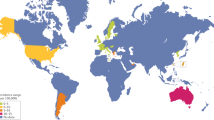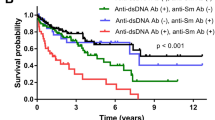Abstract
Systemic lupus erythematosus (SLE) is a multiorgan disease with protean manifestations. Because SLE is uncommon and heterogeneous, its diagnosis can pose a considerable challenge, especially for clinicians with limited expertise of the disease. This is particularly true at the early stages of SLE, when an inadequate number of features to secure the diagnosis might be present, and for patients presenting with uncommon features, which can nonetheless be severe and require prompt treatment. Furthermore, the suboptimal performance of immunological testing in patients referred for possible SLE has been highlighted. As a result, SLE remains largely a clinical diagnosis that is made after excluding alternative diagnoses. Diagnostic criteria can expedite diagnosis and treatment, but are not available for SLE. Thus, SLE classification criteria are often used, but strict adherence to these criteria could delay diagnosis. Therefore, while eagerly awaiting diagnostic criteria for this disease, we propose interim potential solutions to facilitate its diagnosis.
This is a preview of subscription content, access via your institution
Access options
Subscribe to this journal
Receive 12 print issues and online access
$209.00 per year
only $17.42 per issue
Buy this article
- Purchase on Springer Link
- Instant access to full article PDF
Prices may be subject to local taxes which are calculated during checkout

Similar content being viewed by others
References
Uttenthal, B. J., Layton, D. M., Vyse, T. J. & Schreiber, B. E. Clinical problem-solving. The wolf at the door. N. Engl. J. Med. 366, 2216–2221 (2012).
Alonso, M. D. et al. Late-onset systemic lupus erythematosus in Northwestern Spain: differences with early-onset systemic lupus erythematosus and literature review. Lupus 21, 1135–1148 (2012).
Pons-Estel, G. J., Alarcon, G. S., Scofield, L., Reinlib, L. & Cooper, G. S. Understanding the epidemiology and progression of systemic lupus erythematosus. Semin. Arthritis Rheum. 39, 257–268 (2010).
Kamphuis, S. & Silverman, E. D. Prevalence and burden of pediatric-onset systemic lupus erythematosus. Nat. Rev. Rheumatol. 6, 538–546 (2010).
Uramoto, K. M. et al. Trends in the incidence and mortality of systemic lupus erythematosus, 1950–1992. Arthritis Rheum. 42, 46–50 (1999).
Alonso, M. D. et al. Systemic lupus erythematosus in northwestern Spain: a 20-year epidemiologic study. Medicine (Baltimore) 90, 350–358 (2011).
Feldman, C. H. et al. Epidemiology and sociodemographics of systemic lupus erythematosus and lupus nephritis among US adults with Medicaid coverage, 2000–2004. Arthritis Rheum. 65, 753–763 (2013).
Lerang, K., Gilboe, I., Garen, T., Thelle, D. S. & Gran, J. T. High incidence and prevalence of systemic lupus erythematosus in Norway. Lupus 21, 1362–1369 (2012).
Bresnihan, B. Outcome and survival in systemic lupus erythematosus. Ann. Rheum. Dis. 48, 443–445 (1989).
Rivest, C. et al. Association between clinical factors, socioeconomic status, and organ damage in recent onset systemic lupus erythematosus. J. Rheumatol. 27, 680–684 (2000).
Alarcon, G. S. et al. Systemic lupus erythematosus in three ethnic groups. III. A comparison of characteristics early in the natural history of the LUMINA cohort. LUpus in MInority populations: NAture vs. Nurture. Lupus 8, 197–209 (1999).
Alarcon, G. S. et al. Systemic lupus erythematosus in three ethnic groups. II. Features predictive of disease activity early in its course. LUMINA Study Group. Lupus in minority populations, nature versus nurture. Arthritis Rheum. 41, 1173–1180 (1998).
Hiraki, L. T. et al. Prevalence, incidence, and demographics of systemic lupus erythematosus and lupus nephritis from 2000 to 2004 among children in the US Medicaid beneficiary population. Arthritis Rheum. 64, 2669–2676 (2012).
Cervera, R. et al. Systemic lupus erythematosus: clinical and immunologic patterns of disease expression in a cohort of 1,000 patients. The European Working Party on Systemic Lupus Erythematosus. Medicine (Baltimore) 72, 113–124 (1993).
Nossent, J. et al. Disease activity and damage accrual during the early disease course in a multinational inception cohort of patients with systemic lupus erythematosus. Lupus 19, 949–956 (2010).
Cerovec, M., Anic, B., Padjen, I. & Cikes, N. Prevalence of the American College of Rheumatology classification criteria in a group of 162 systemic lupus erythematosus patients from Croatia. Croat. Med. J. 53, 149–154 (2012).
Cross, L. S., Aslam, A. & Misbah, S. A. Antinuclear antibody-negative lupus as a distinct diagnostic entity—does it no longer exist? QJM 97, 303–308 (2004).
Mosca, M., Tani, C. & Bombardieri, S. Defining undifferentiated connective tissue diseases: a challenge for rheumatologists. Lupus 17, 278–280 (2008).
Calvo-Alen, J. et al. Systemic lupus erythematosus: predictors of its occurrence among a cohort of patients with early undifferentiated connective tissue disease: multivariate analyses and identification of risk factors. J. Rheumatol. 23, 469–475 (1996).
Nimelstein, S. H., Brody, S., McShane, D. & Holman, H. R. Mixed connective tissue disease: a subsequent evaluation of the original 25 patients. Medicine (Baltimore) 59, 239–248 (1980).
Gendi, N. S. et al. HLA type as a predictor of mixed connective tissue disease differentiation. Ten-year clinical and immunogenetic followup of 46 patients. Arthritis Rheum. 38, 259–266 (1995).
Cappelli, S. et al. “To be or not to be,” ten years after: evidence for mixed connective tissue disease as a distinct entity. Semin. Arthritis Rheum. 41, 589–598 (2012).
Amezcua-Guerra, L. M. et al. Presence of antibodies against cyclic citrullinated peptides in patients with 'rhupus': a cross-sectional study. Arthritis Res. Ther. 8, R144 (2006).
Aringer, M. & Smolen, J. S. Efficacy and safety of TNF-blocker therapy in systemic lupus erythematosus. Expert Opin. Drug Saf. 7, 411–419 (2008).
Sjowall, C. et al. Abnormal antinuclear antibody titers are less common than generally assumed in established cases of systemic lupus erythematosus. J. Rheumatol. 35, 1994–2000 (2008).
Meroni, P. L. & Schur, P. H. ANA screening: an old test with new recommendations. Ann. Rheum. Dis. 69, 1420–1422 (2010).
Craig, W. Y. & Ledue, T. B. The antinuclear antibody assay: developing criteria for reflexive anti-dsDNA antibody testing in a laboratory setting. Clin. Chem. Lab. Med. 49, 1205–1211 (2011).
Compagno, M. et al. Low diagnostic and predictive value of anti-dsDNA antibodies in unselected patients with recent onset of rheumatic symptoms: results from a long-term follow-up Scandinavian multicentre study. Scand. J. Rheumatol. http://dx.doi.org/10.3109/03009742.2013.765032
Swaak, T. & Smeenk, R. Detection of anti-dsDNA as a diagnostic tool: a prospective study in 441 non-systemic lupus erythematosus patients with anti-dsDNA antibody (anti-dsDNA). Ann. Rheum. Dis. 44, 245–251 (1985).
Danieli, M. G., Fraticelli, P., Salvi, A., Gabrielli, A. & Danieli, G. Undifferentiated connective tissue disease: natural history and evolution into definite CTD assessed in 84 patients initially diagnosed as early UCTD. Clin. Rheumatol. 17, 195–201 (1998).
Arbuckle, M. R. et al. Development of autoantibodies before the clinical onset of systemic lupus erythematosus. N. Engl. J. Med. 349, 1526–1533 (2003).
Wandstrat, A. E. et al. Autoantibody profiling to identify individuals at risk for systemic lupus erythematosus. J. Autoimmun. 27, 153–160 (2006).
Mariz, H. A. et al. Pattern on the antinuclear antibody-HEp-2 test is a critical parameter for discriminating antinuclear antibody-positive healthy individuals and patients with autoimmune rheumatic diseases. Arthritis Rheum. 63, 191–200 (2011).
Ahearn, J. M., Liu, C. C., Kao, A. H. & Manzi, S. Biomarkers for systemic lupus erythematosus. Transl. Res. 159, 326–342 (2012).
Li, Q. Z. et al. Risk factors for ANA positivity in healthy persons. Arthritis Res. Ther. 13, R38 (2011).
Li, Q. Z. et al. Interferon signature gene expression is correlated with autoantibody profiles in patients with incomplete lupus syndromes. Clin. Exp. Immunol. 159, 281–291 (2010).
Braunstein, I., Klein, R., Okawa, J. & Werth, V. P. The interferon-regulated gene signature is elevated in subacute cutaneous lupus erythematosus and discoid lupus erythematosus and correlates with the cutaneous lupus area and severity index score. Br. J. Dermatol. 166, 971–975 (2012).
Sood, R., Wong, W., Gotlib, J., Jeng, M. & Zehnder, J. L. Gene expression and pathway analysis of immune thrombocytopenic purpura. Br. J. Haematol. 140, 99–103 (2008).
Feng, X. et al. Type I interferon signature is high in lupus and neuromyelitis optica but low in multiple sclerosis. J. Neurol. Sci. 313, 48–53 (2012).
Mackay, M. et al. Molecular signatures in lupus: untangling infection from inflammation. Arthritis Rheum. 64, S1088 (2012).
Li, Q. Z. et al. Protein array autoantibody profiles for insights into systemic lupus erythematosus and incomplete lupus syndromes. Clin. Exp. Immunol. 147, 60–70 (2007).
Silverman, G. J. et al. Genetic imprinting of autoantibody repertoires in systemic lupus erythematosus patients. Clin. Exp. Immunol. 153, 102–116 (2008).
Grimes, D. A. & Schulz, K. F. Refining clinical diagnosis with likelihood ratios. Lancet 365, 1500–1505 (2005).
Somers, E. C., Antonsen, S., Pedersen, L. & Sorensen, H. T. Parental history of lupus and rheumatoid arthritis and risk in offspring in a nationwide cohort study: does sex matter? Ann. Rheum. Dis. 72, 525–529 (2013).
Kassirer, J. P. Teaching clinical reasoning: case-based and coached. Acad. Med. 85, 1118–1124 (2010).
Tan, E. M. et al. The 1982 revised criteria for the classification of systemic lupus erythematosus. Arthritis Rheum. 25, 1271–1277 (1982).
Hochberg, M. C. Updating the American College of Rheumatology revised criteria for the classification of systemic lupus erythematosus. Arthritis Rheum. 40, 1725 (1997).
Calvo-Alen, J. et al. Identification of patient subsets among those presumptively diagnosed with, referred, and/or followed up for systemic lupus erythematosus at a large tertiary care center. Arthritis Rheum. 38, 1475–1484 (1995).
Petri, M. et al. Derivation and validation of the Systemic Lupus International Collaborating Clinics classification criteria for systemic lupus erythematosus. Arthritis Rheum. 64, 2677–2686 (2012).
Alarcon, G. S., McGwin, G. Jr, Madger, L. & Petri, M. Comparing the ACR and the SLICC criteria for the classification of SLE patients using data from an existing multi-ethnic cohort. Arthritis Rheum. 64, S262 (2012).
Acknowledgements
We wish to thank D. Vassilopoulos, I. Gergianaki and M. Drandaki for their thoughtful comments.
Author information
Authors and Affiliations
Contributions
All authors contributed to researching data for the article, discussing its content, writing the article and reviewing/editing it before publication.
Corresponding author
Ethics declarations
Competing interests
The authors declare no competing financial interests.
Supplementary information
Supplementary Table 1
The ACR and SLICC classification criteria for SLE. (DOCX 31 kb)
Supplementary Table 2
Diagnostic performance of individual features for established SLE patients seen in academic referral centers. (DOCX 27 kb)
Supplementary Table 3
Common cognitive biases and flaws in SLE diagnosis and management. (DOCX 24 kb)
Supplementary Figure 1
Fagan's normogram for calculating post-test probability after considering lupus laboratory tests. (DOCX 62 kb)
Rights and permissions
About this article
Cite this article
Bertsias, G., Pamfil, C., Fanouriakis, A. et al. Diagnostic criteria for systemic lupus erythematosus: has the time come?. Nat Rev Rheumatol 9, 687–694 (2013). https://doi.org/10.1038/nrrheum.2013.103
Published:
Issue Date:
DOI: https://doi.org/10.1038/nrrheum.2013.103
This article is cited by
-
Cytotoxic Tph subset with low B-cell helper functions and its involvement in systemic lupus erythematosus
Communications Biology (2024)
-
Burden of disease and real-world treatment patterns of patients with systemic lupus erythematosus in the Australian OPAL dataset
Clinical Rheumatology (2023)
-
Evaluating the performance of ACR, SLICC and EULAR/ACR classification criteria in childhood onset systemic lupus erythematosus
Pediatric Rheumatology (2021)
-
Autophagy receptor CCDC50 tunes the STING-mediated interferon response in viral infections and autoimmune diseases
Cellular & Molecular Immunology (2021)
-
New Criteria for Lupus
Current Rheumatology Reports (2020)



